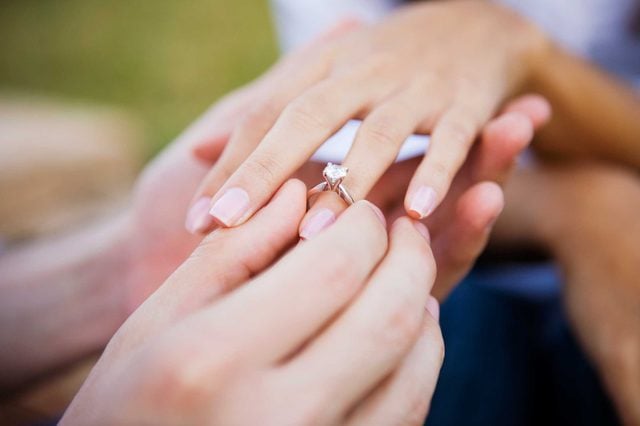Here’s the Real Reason We Propose with Engagement Rings
Updated: Mar. 14, 2024
The history behind this tradition dates back to ancient times, and it wasn't always so romantic.
 Congratulations! You’ve found The One, the person you want to spend the rest of your life with, and you’re ready to pop the question. What are you going to do next? Buy a ring, of course. That’s what you’re supposed to do, right?
Congratulations! You’ve found The One, the person you want to spend the rest of your life with, and you’re ready to pop the question. What are you going to do next? Buy a ring, of course. That’s what you’re supposed to do, right?
Well, yes, but why? Don’t get me wrong: Rings are gorgeous. I’m very glad proposals include engagement rings and not engagement cards. But if you are willing to do anything for your soon-to-be spouse, why give a ring? ( Also, check out this hack to get ring off a swollen finger.)
Actually, it’s a tradition dating back to the ancient Egyptians, who believed circles were symbols of eternity. Wedded couples exchanged rings made out of braided reeds. These were worn on the left hand ring finger, which apparently had a vein that ran directly to the heart, later named Vena amoris. (If you’re on a search for your soulmate, beware of the signs your partner only sees you as a fling.
Fast-forward to the 2nd century B.C., when the ancient Romans are believed to have started the tradition of betrothal rings in lieu of giving the bride money or a valuable object. But its symbolism wasn’t so much about love as it was ownership. According to Pliny the Elder, the groom first gave the bride a gold ring to wear during the betrothal ceremony and at special events, then an iron ring to wear at home, signifying her binding legal agreement to his ownership of her.
[pullquote] Now more than 80 percent of American brides get diamond engagement rings. [/pullquote]
Diamonds didn’t appear on engagement rings until centuries later. One of the first recorded uses of a diamond engagement ring was in 1477. Archduke Maximilian of Austria proposed to Mary of Burgundy with a ring set with thin, flat pieces of diamonds in the shape of an “M.” This set a glamorous precedent for European nobility, who added more precious gems to their jewelry. The Middle Ages also saw the rise of “posey rings,” bands engraved with romantic love poems and sayings.
Everything changed when diamonds were discovered in South Africa. In 1880, Cecil Rhodes founded the DeBeers Mining Company with other investors. Within the decade, they controlled 90 percent of the world’s diamond production—and turned diamond engagement rings into nothing more than an ad campaign. Once the Great Depression ended, the company’s ad agency N.W. Ayer & Son launched its famous “A diamond is forever” slogan and encouraged men to spend two months’ salary on the rock. By the early 1940s, engagement rings become the leading line of jewelry in most department stores.
Now more than 80 percent of American brides get diamond engagement rings. According to a report by Jewelers of America, an average of $4,000 was spent on engagement rings by couples in 2012. Sure it can be pricey, but it’s a whole lot more romantic than the earliest mating rituals: A caveman tied cords made of braided grass around his chosen mate’s wrists, ankles, and waist, to bring her spirit under his control.